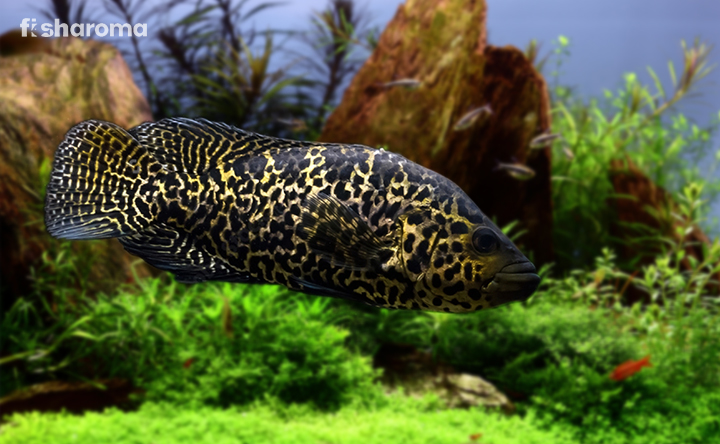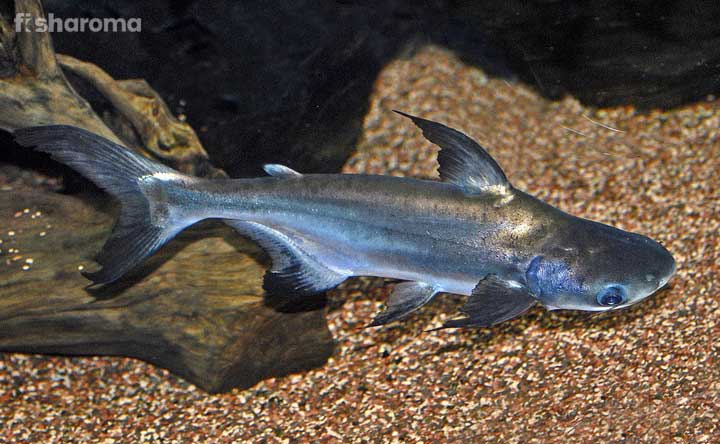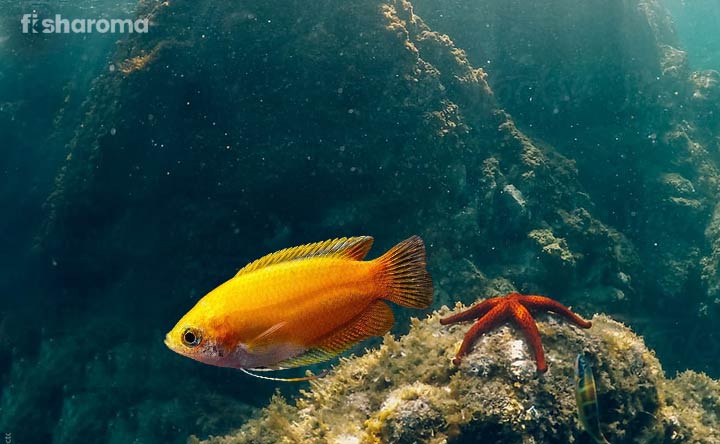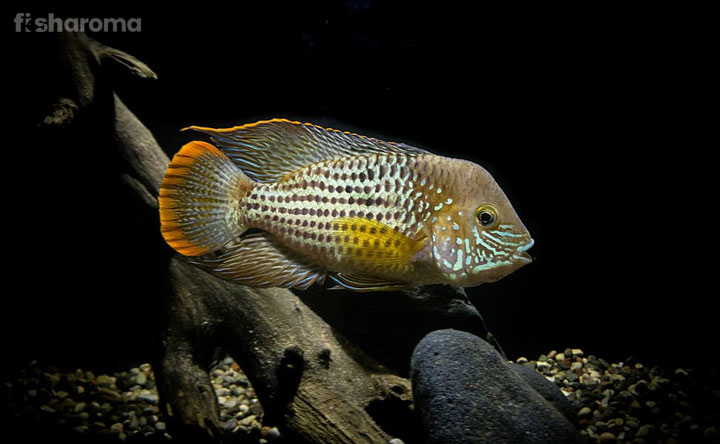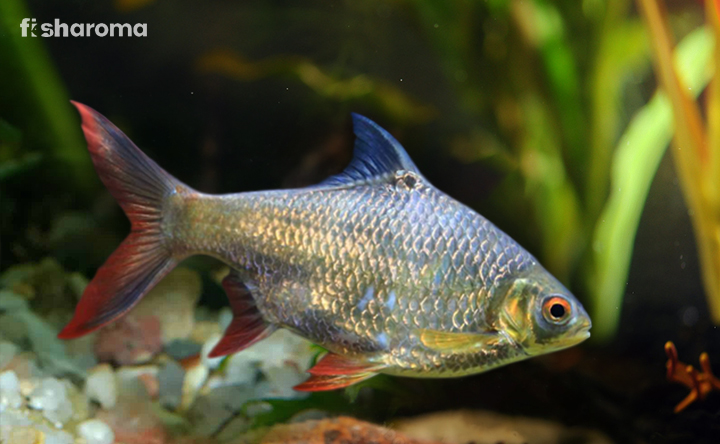Sailfin Pleco- The Ultimate Care Guide to Leopard Pleco

Sailfin Pleco is a household star. This variant is a pleco of immense popularity, out of over 150 species of the same. The unique patterns on their body never fails to fetch your attention. The outlook of a Sailfin Pleco isn’t everything that makes them popular, as they have a long lifespan.
Longevity in life is something that most aquarists seek, besides other important factors like beauty, care regime and more. Along with that, Plecos in general are easy to take care of. However, in this article, we’ll cover everything you need to know about our magnificent Plecostomus, Sailfin Pleco. Read on, to know it all!
Key Specifications
Here goes a few key elements you need to check before you get started:
| Scientific Name | Pterygoplichthys gibbiceps |
| Origin | South America |
| Lifespan | 15-20 years |
| Colours/Patterns | Black & Brown with leopard-like patterns |
| Temperament | Territorial, shows aggression to similar species. (Other plecostomus) |
| Size | 13-19.7 inches |
| Diet | Omnivorous |
| Family | Loricariidae (Armoured Catfish) |
| Compatibility | Compatible in a peaceful community or with sociable fishes. Shows territorial nature against same or similar species. |
| Tank size | 100 gallons (125 gallons recommended) |
| Care level | Easy |
| Water preference | Freshwater |
Overview
Sailfin Pleco is also known by other names like leopard pleco, high fin spotted plecostomus, spotted sailfin pleco, high fin pleco, columbian spotted pleco, leopard sailfin pleco and gibbiceps pleco. They are originally from the family of Armoured Catfish, growing pretty large in size. Quite evidently they can live for as long as 20 years even under captive conditions. These freshwater Suckermouth Catfish wonders are famous, out of so many species of Plecostomus.
Origin and Habitat of Sailfin Pleco
Originating from the waters of South America you will mostly find the wonderful Sailfin Pleco in the rivers, along with its tributaries. The Orinoco river basins of Peru, Ecuador, Venezuela and Brazil along with the Amazonian river basins are where these wonderful suckermouth catfishes essentially originate. In Brazil, they are specifically found in the Shingu and Tefe rivers as well.
However, due to massive place shifting and migration, these lovely pleco fishes have managed to exist in the South American waters as mentioned earlier. However, the South American Sailfin Plecostomus prefers waters that are not very deep with a tranquil flow.
Sailfins are not the most rigorous swimmers. Usually, these Plecostomus prefer water with soft currents and slow flow. This provides them with enough comfort to dwell in the bottom layer, swimming about and existing in peace.
Appearance of Sailfin Pleco
The Sailfin or Leopard Plecos possess a really bold look, with a tough bone-plate like settlement around the stomach. Their nostrils protrude amidst their pretty large heads. Factually, they are one of the bigger Plecostomus species out there. Naturally, their aura is very impactful when you see them wandering in the bottom layer of your lovely freshwater aquarium.
The mouth structure of these Plecos are usually flat, enabling them to intake enough oxygen with large gulp-ins in case of an oxygen deficiency in the aquarium water. Even the positioning of their eyes allows them to have a wide visual range.
The eyes are located appropriately on the top of their large head, causing ease in their widespread visual prowess. The fins of a Sailfin Pleco are naturally well designed with bony accents, where the dorsal fin is comparatively huge with a single ray alongside the similarly bony pectoral fins.
This unique structure gives them the special strength to dig deep into the substrate layer. Hence, the armour name is put to glory with their hardy structure coming to proper use. All in all, the overall structure of a Sailfin Pleco is certainly fascinating.
Time to brief you up with some distinguished features that catches your eye:
Colour
Coming to the colours and vibrancies of a Sailfin, figuratively they have a very bold colouration on pattern balance. In simpler words, their simple black on brown colourplay gives them the appearance of a leopard. In this way, in many spaces they are commonly well-known as the Leopard Pleco as a result of their unique patterned appearance. This makes them really stand out from all the different Plecostomus species. However, there is a clear segregation. Let us learn a little more about them:
- Marbled Pleco
- Spotted Sailfin Pleco
- Leopard Sailfin Pleco
- Albino Sailfin Pleco (They don’t have any spots unlike the other variants mentioned above)
Size
These Plecos tend to be quite large, compared to other common Plecos we usually see in the aquarium business. They are actually pretty large for a bottom-dweller comparatively. These Plecostomus may appear intimidating, but let us assure you that their appearance fails to match their temperament. You will learn more on this species as you proceed.
Behaviour of Sailfin Pleco
Sailfin Plecos have literally two moods. At times they are active, where a visible chunk of movement and swimming around is noticed. While on the other hand, at times, they tend to be the most peaceful beings with limited movement around the substrate layer. Even when they are not categorized as the typical nocturnal species, you will see them showing a massive bit of movement when it’s dark outside.
You will not notice any signs of aggression in them, as they are naturally peaceful species. However, you will see the territorial side of them when you introduce other Pleco species in your aquarium. It is a part of their behavioural characteristic to show aggression in a same-species tank. No matter how big their size is, they pose no threat to smaller fish species. So it is safe to keep them in a community tank, despite their comparatively huge frame.
Lifespan of Sailfin Pleco
As we’ve talked about it in the earlier sections of the care guide, the lifespan on these beauties is pretty commendable. Living for as long as 20 long years with a bottom-line of at least 15 years, Leopard Plecos are strong and hardy.
Diet of Sailfin Pleco
These Plecos have an omnivorous preference when it comes to their diet. However, often at times you can notice them nibbling on the aquarium plant matter. Plecos are known to be fans of algae-based feedable, pure algae and even deceased pieces of meat. Just make sure when it comes to commercially processed food items, you prevent flakes. We suggest you to choose fish pellets over flakes at all times.
Make sure when you ratio their foods, consider more vegan or vegetarian food options over other types of food (8:2). They are not all bad, as you find them nibbling on your aquarium vegetation. You see, they are efficient tank cleaners. Being so, they keep the conditions of your aquarium neat by feeding on the unnecessary algae growth in your tank.
This presence of algae often tends to bother the chemistry of your tank water, requiring excessive maintenance. So, in this case, if you have these majestic beings in your tank, that’s never a worry. The Sailfins would willingly take care of that by passionately feeding on the algae. Still, don’t forget to cut down a little on the food you provide them if they are already taking care of a pre-existing “algae-problem” in your tank.
To have a proper idea of their diet, take a look at these:
Vegan/Vegetarian food options- (Helps in enhancing growth)
- Zucchini
- Cucumber
- Carrots
- Spinach
- Algae (Wafers, Overgrowth & more)
Other good food options- (Keep away from scavengers as Sailfins are not competitive eaters)
- Bloodworms
Tank Requirements for Sailfin Pleco
Let us present you with the necessary tank requirements that you need to take care of, if you wish to introduce these lovelies to your tank. A proper freshwater-friendly setting for large tanks, keeping all their other requirements in mind, is necessary.
Tank Lid
It is correct that they could be active at times, especially at night. But their falling out risks are low as they neither dwell near the surface or prefer to rapidly swim around all the time. Still, the importance of a tank lid in this case is significant as they prevent dust particles from accumulating in the tank.
Water pollution is something that can severely hamper the Pleco’s health, so a tank lid or hood prevents that from happening. Plus, it also acts as an external sheath of protection if you have any curious domestic pets in the house.
Nevertheless, it is important for you to consider that sometimes when you introduce a new Sailfin Pleco to your aquarium, it may get anxious. Either because of that or due to shortage of oxygen in the aquarium, this Pleco can be seen dwelling near the surface or even jumping out. In that case, the importance of a Tank Lid faces a major hike, as it prevents accidents of that nature from not happening.
Tank Size
The Sailfins are large Plecostomus species, with size growing as big as 19 inches. Naturally they require an average tank size of 100 gallons. However, to provide them with some buffer space and additional comfort, you can opt for a bigger tank around 125 gallons.
Substrate
A fine substrate of sand should do just fine. Substrate layer of this nature successfully supports these Plecos’ sand-burrowing nature, hence, making it a great choice.
Filter
To go with our recommendation, we suggest you to opt for a canister filter or any filter suitable to take care of the filtration process of a large aquarium. The importance of filtration is high, along with proper aeration and oxygenation of the tank.
Ornaments
Add some cellulose infused wood for the good gut health of your beauties. Otherwise, driftwood works just fine, as it can act as a good catalyst for algae growth in your tank. More the algae growth, the happier your Sailfins get. Make sure there’s enough cover, by adding elements like rocks or appropriate decorations like caves, pots and more. This essentially facilitates this Pleco’s hiding nature.
Lighting
We suggest you to keep the lighting moderate. If not technically, their behaviourisms suggest nocturnal traits. So neither extremely high nor low intensities can work for them. Best to keep it medium, simply checking all the boxes out there.
It is also preferable for you to install a night light setting or a moonlight setting, to be able to see your Plecos at night.
Presence of Flora
Live and beautiful aquarium plants work fine in a Sailfin Pleco tank. Don’t forget to choose tough aquarium plant species, as they have nibbling tendencies. These Plecos nibble away and feed on these aquarium plants. If your choice is delicate, you’ll never be able to keep plants in your tank unbothered. Good low-light freshwater aquarium plant options are always welcome.
Hardy aquarium plant choices last long against our precious plant-loving Plecostomus. Otherwise, floating plant options turn out to be good choices. These bottom-dwelling catfish species would barely or never reach out to the surface to feed.
We suggest you to choose plants like:
- Anubias Nana
- Java Moss
- Java Fern
- Amazon Sword
- Jungle Vallisneria
Cleaning Method
Keep the water replacement procedure intact, do it on alternate days. The waste production in Sailfin Plecos is pretty high, so it is necessary for you to keep the tank clean and well-maintained.
Make sure your filtration system aligns well with the waste reduction demand of your aquarium. Do not forget to clean the tank walls with the application of a soft cotton cloth, in order to get rid of excess dirt. Keep the tank’s ecosystem intact!
Water Type for Sailfin Pleco
Water Parameters are like pillars, holding the sanity of your aquarium. A lot of factors depend on the balance of water parameters or the water profile itself. If not maintained with sincerity, things could be really detrimental for the health of these wonderful catfish species.
The necessary water profile for Sailfin Pleco:
| Hardness | 2-20 dGH, 6-10 dKH |
| Temperature | 22-29 Degrees Celsius |
| pH | 6.5-7.5 |
Hardness
The Sailfins prefer a carbonate hardness range of 6-10 dKH, where the general hardness should be around 2-20 dGH. This ray-finned beauty clearly has a wide range of tolerance, making them visibly hardy in nature.
Temperature
These Plecos like their water to be on the warmer side, hence, a temperature range of 22-29 Degrees Celsius has been recommended.
pH
The pH of the water is very crucial for the health of fishes in general, let alone Plecos. So make sure your pH range does not exceed 6.7-7.5.
Compatibility of Sailfin Pleco
Sailfin Plecos or Leopard Plecos are compatible with most peaceful species of fish. As mentioned, they do tend to get territorial against the same or other Plecostomus species. These beauties are capable of defending themselves by locking their fins (pectoral) at a certain angle (90 Degrees). So much so, that the structural complexity never allows a predator to swallow them off with ease. As it is not easy to bother them either, active, playful schooling fishes fail to bother them and can be kept together with harmony.
However, the best course of action would be to keep species, that are even larger than them away. This may cause some sort of stress or anxiety in your lovely Plecos, which is something you definitely want to prevent. Be it small social fishes of the community or similar sized fish, these big Plecos pose no threat to them or even chase them at the very least.
Suitable Tank mates
Let’s you a proper idea, by stating a list of suitable tank mates you can pair them up with:
- Congo Tetra
- Black Skirt Tetra
- Bloodfin Tetra
- Kuhli Loach
- Clown Loach
- Green Terror Cichlid
- Jewel Cichlid
- Sparkling Gourami
- Honey Gourami
- Pearl Gourami
and more.
Unsuitable Tank mates
Abstain from adding bigger or predatory fish species. Also make sure you’re keeping them amidst a community of peaceful fishes or active fishes, which are not very aggressive.
We recommend you to never keep them in a species-specific aquarium, as they hate the same or similar species. Their strong dislike or territorial instincts against other species of Plecostomus has been thoroughly discussed in the behaviour section.
Breeding of Sailfin Pleco
Complications while breeding them at home:
As a result of their large size, it could be really complex if you try to breed a breed-able Sailfin Pleco pair at home. Their tank requirements are highly demanding at the time of breeding. Thus, this normalizes the breeding process of this fish to be carried out in in-bound water bodies like ponds and so on. Even the gender identification and separation process before the on-set of breeding is complicated.
Naturally there are no known reports of this catfish species successfully breeding in a home aquarium as muddy water is a must for them. Especially, at the time of breeding, it is not the easiest thing to facilitate and attend to all of their high requirements. Conclusively, replication of their breeding process could be simply termed impossible even by most aquarists of advanced calibre.
Breeding in their natural habitat
If you take a closer look at their natural habitat, they have behaviourisms of digging deep in the bottom-most layer of the water body to lay eggs. An average female Sailfin Pleco can lay upto 500 eggs, where the minimum number of eggs so laid, is at least 120!
How does it actually work?
The breeding starts with the adult Sailfin male sort of pursuing the female Pleco to fertilize. After the breeding is complete, the male essentially guards the eggs showing strong parental instincts. It mostly happens in the night time, as we’ve pre-learned that, this Plecostomus species prefers a chunk of its activities when the sun is down.
The male Sailfins also guard post-hatch, protecting their juveniles in a vulnerable state. It usually takes a few days for the eggs to hatch, where the new fry feeds on their own yolk sac for a limited period of time.
Make sure to feed them bite-sized feedable options, in case you purchase Leopard Plecos in their young or juvenile state as it is impossible to breed them at home. Food items like infusoria can provide them with the required nutrition boost at first. Otherwise, Catfish Tablets also turn out to be a good eating choice for the young.
Diseases of Sailfin Pleco
Sailfin Pleco or Leopard Plecos are known to be hardy species, with high endurance. However, that does not make them invincible when it comes to the horrible freshwater diseases. It is common for most common freshwater diseases to evidently affect their health, be it for water chemistry fluctuations or infections from other fishes in the community.
Therefore, let us have a look at few of the most common diseases that these majestic being are mostly prone to:
- Ich or the White Spot Disease (Caused by Ichthyophthirius multifiliis, which is a parasitic ciliate)
- Flukes (Mainly on the skin and gills)
- Change in Behavioural Patterns
These are the most common diseases and symptoms that you will find in Sailfin Plecos. So if you notice any abnormal cuts, wounds, pale spots or blotches on your fish, it’s time you seek immediate medical attention.
Treatment
No matter how hardy and endurable these catfish species are, even when the lightest symptoms are left untreated, it could take a severe shape. These suckermouth catfishes should be kept in pristine water conditions. The conditions of your aquarium water should be well-maintained with proper water parameters and hygiene.
- Make sure you keep a close eye to your aquarium, for early detection of illnesses. This will make the treatment process immediate or rapid.
- Isolate the ill Pleco immediately, in order to prevent further spread of the freshwater disease within the healthy community of fishes.
- Don’t forget to properly take care of the water profile. The parameters must be well-maintained for the Pleco’s health sake.
Summary
The Sailfin Plecos are lovely fishes, of unique appearance and mannerisms. They have an easy care routine, making them suitable for most aquarists or fishkeepers in the hobby. Additionally, they are hardy being categorized under the group or family of Loricariidae or the Armoured Catfish.
Seems, they can defend themselves quite well! The leopard-like appearance leaves any observer mesmerized. All these factors and their tough immunity against most freshwater diseases makes them a neat choice for your aquarium.
Similar Care Guides You may like
- Peacock Gudgeon Care Guide: This, yet another magnificent freshwater fish species is from New Guinea! The vibrancies and pattern-work on them is truly eye-catching. Know more about them right here!
- Female Betta Fish Care Guide:This freshwater beauty is the one to lookout for. They enhance the aesthetics and aura of your aquarium by a lot. To know more, click here.
- Sterbai Cory Fish Care Guide: This lovely Corydoras Catfish species will keep you mind boggled with their interesting features and outward appearance. Curious? Check this out.

